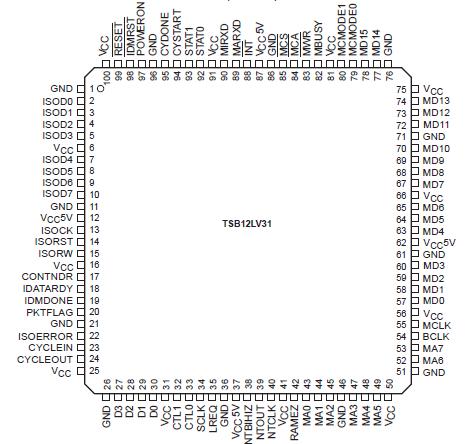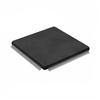Features: • Provisions of IEEE 1394-1995 Standard for High-Performance Serial Bus (1394)†
• Fully Interoperable with FireWireE Implementation of 1394
• Compatible with Texas Instruments TSB11LV01 and TSB21LV03 Physical Layer Controllers (Phys)
• Single 3.3-V supply operation with 5-V Tolerant Capabilities using 5-V Bias Terminals
• High-performance 100-Pin PZ (SPQFPG100) package.
• Programmable Microcontroller Interface with 8-Bit or 16-Bit Data Bus, Three Modes of Operation, and Clock Frequency to 50 Mhz
• 50-quadlet (200-Byte) FIFO Accessed Through Microcontroller Interface Supports
Asynchronous and Isochronous Operations
• Programmable FIFO Size For Asynchronous Transmit FIFO and General-Receive FIFO
• Single-Channel Support for Isochronous Transmit from Unbuffered 8-Bit Isochronous Port (IsoPort)
• Isochronous Receive to FIFO or to Unbuffered 8-Bit IsoPort
• Isochronous Header Synchronous-Bit Detection on Receive
• Automatically Reports IRM NODE_ID and Verifies Automatic 1394 Self-ID
• Transfer Rates of 100 Mbits/s and 200 Mbits/s
• Asynchronous Packet Reception to Internal FIFO (Accessed Through the Microcontroller Interface)
• Asynchronous Packet Transmission from Internal FIFO (Accessed Through the Microcontroller Interface)
• Generation of External Microcontroller Clock from SCLK (SCLK/4)
• Generation of 32-Bit Cyclic Redundancy Check (CRC) for Transmission of 1394 Packets
• 32-Bit CRC Checking on Reception of 1394 Packets
Pinout Specifications
SpecificationsSupply voltage range, VCC . . . . . . . . . . . . . . . . . . . . . . . . . . . . . . . . . . 0.5 V to 4 V
Supply voltage range, VCC5V . . . . . . . . . . . . . . . . . . . . . . . . . . . .. . . 0.5 V to 5.5 V
Input voltage range, VI (5-V tolerant TTL terminals) . . . . . . .0.5 V to VCC5V+ 0.5 V
Output voltage range, VO (TTL terminals) . . . . . . . . . . . . . . 0.5 V to VCC5V + 0.5 V
Input clamp current, IIK (VI < 0 V or VI > VCC) (see Note 1) . . . . . . . . . . . . . ±20 mA
Output clamp current, IOK (VO < 0 V or VO > VCC) (see Note 2) . . . . . . . . . . ±20 mA
Continuous total power dissipation, PD . . . . . . . . . . . . . (see dissipation rating table)
Operating free-air temperature range, TA: TSB12L31 . . . . . . . . . . . . . . 0°C to 70°C
Operating free-air temperature range, TA:TSB12L31I . . . . . . . . . . . .40°C to 85°C
Operating free-air temperature range, TA:TSB12L31M . . . . . . . . . . 55°C to 125°C
Storage temperature range, Tstg . . . . . . . . . . . . . . . . . . . . . . . . . . 65°C to 150°C
NOTES:
1. This parameter applies to external input and bidirectional buffers without hysteresis. VI > VCC does not
apply to fail-safe terminals. For 5-V tolerant and universal PCI use VO > VCC 5 V.
2. This parameter applies to external input and bidirectional buffers without hysteresis. VO > VCC does not
apply to fail-safe terminals. For 5-V tolerant and universal PCI use VO > VCC 5 V.
DescriptionThe TSB12LV31 performs bidirectional asynchronous/isochronous data transfers to and from an IEEE 1394-1995 serial bus physical layer (phy) device. The TSB12LV31 is tailored and optimized for use as a peripheral link-layer controller (LLC). TSB12LV31 asynchronous and isochronous operations are summarized as follows:
TSB12LV31 asynchronous transmit: From asynchronous transmit FIFO (ATF)
TSB12LV31 asynchronous receive: To general receive FIFO (GRF)
TSB12LV31 isochronous transmit: From 8-bit IsoPort
TSB12LV31 isochronous receive: To 8 bit IsoPort,
To GRF, or
To 8-bit IsoPort and To GRF
This document is not intended to serve as a tutorial on the 1394; users should refer to the IEEE 1394-1995 standard for more detailed information.

 TSB12LV31 Data Sheet
TSB12LV31 Data Sheet








